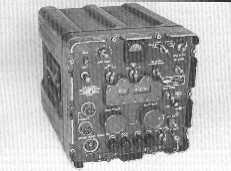
This page last revised December 10, 1999.
The R-392 receiver was designed in the late 1940's (or maybe the early 1950's) to provide shortwave reception to US Army units. The receiver was typically mounted on a Jeep or small truck (at 52 pounds, it's way too heavy for a soldier to carry in the field.) The receiver was designed with a watertight (!) enclosure. Look up the word "rugged" in a dictionary; you might well find a picture of the R-392:

Is this radio pretty, or what? Wouldn't it look great on your living room coffee table?
(Photo courtesy of Walt Hutchens KJ4KV and Electric Radio)
Looking for some more info on the R-392? Check out Josh Rovero's website; he's obviously spent a lot of time on it, and he's got a very well organized treatise (with schematics, and lots of links!) on the R-392.
And if you need a copy of the maintenance manual, or the operations manual, I'd recommend you get a copy of the CDROM which Jeffrey L. Adams puts out. This CDROM includes Adobe Acrobat (.pdf) files of R-392 maintenance and operations manuals, along with similar manuals for the R-389, R-390, R-390A, and R391 radios; a great buy for 10 bucks! (US customers only; contact Jeff below for international orders) To order the CD, send US $10.00, along with a gummed mailing address label with your mailing address on it (or a hand addressed label which Jeff can tape to the mailer), to:
Jeffrey L. Adams
210 Kent Ave.
Fredericksburg VA 22405 USA
(Be sure to PRINT the mailing address label.)
If you need additional info (or pricing for international shipment), you can email Jeff at eengineer@erols.com, or visit his web site at
http://www.erols.com/eengineer (which includes some other fun boatanchor stuff!)
If you've got (or are considering getting) one of these radios, you will probably need certain tools. First, you'll need a spline wrench (also referred to as bristo wrench, or bristol wrench). (When these radios were initially built, a wrench was included inside the case, but nowadays most of the radios which I've seen have been missing the wrench.) The size is 0.096 inch, 6 flute. A good source is McMaster-Carr; I'd recommend a couple of the standard short-arm size (at about 80 cents each, last time I checked) and, if you really want to treat yourself, one of the "driver" types (has a screwdriver-type handle, costs 7 bucks; this will make some of the setscrew adjustments sooo much easier).
Also, some of these radios have thumbscrews to open the case; others have hex screws (also called "allen" screws). If yours has hex screws, you'll want to keep a 3/16 inch hex/allen wrench handy. Also available from McMaster-Carr; consider one of medium length (about 6 inches), or better still, a T-handle style.
Maintenance? Well, like many other 40 or 50 year old boatanchors, you may have to one day consider checking for bad resistors and capacitors. Here's a list of resistors and capacitors which I put together, tabulating many of the components which I consider prone to aging (and worthy of checking every few decades).
Tubes? I can offer no real suggestions for sources; you'll have to check the 'net. But I do have a supply of 26D6 tubes which I am selling; click here for details.
And how about modifications? Well, I've got some suggestions. Of course, you are free to ignore them if your tastes are more towards original equipment operation. And, several months ago, a visitor to my site offered his own experiences with solid state modifications; I've reproduced the correspondence here.